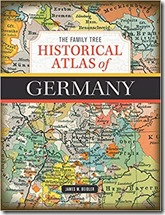 Title: The Family Tree Historical Atlas of Germany
Title: The Family Tree Historical Atlas of Germany
Author: James M. Beidler
Format: Paperback
Published: 2019
The following review first appeared in the Federation of Genealogical Societies FORUM magazine (Winter 2019); reprinted with permission.
This post contains affiliate links.
The history of Germany is a complicated subject. But there are pieces of Germany’s history that are important to family history researchers. The Family Tree Historical Atlas of Germany tells the story of Germany’s evolution through maps, from ancient times to the present, and is a useful resource for genealogists.
The book begins with a brief introduction and then dives into a short history of Germanic lands. The bulk of the book is divided into eight parts—the maps! Each part has a brief introduction relevant to the time period or topic discussed. In most cases, these introductions remind readers of the history elements discussed at the beginning of the book and often dig a little deeper.
A variety of maps are presented in the book, many of them historical maps, either developed during the time period for which they depict or created after in retrospect. Most of the maps depict political boundaries, but there are other types of maps such as demographic maps. The author recommends using a magnifying glass, but also notes that a good portion of the maps are available online (which may offer a clearer view with the ability to zoom in). Also important to note is that many of the maps are written in German.
Shockingly, there is a village index. However, it does not appear to note all of the villages depicted on the maps presented in the book. But, this book is not intended to serve as a gazetteer, and there is no way that every little village can be depicted among the maps within a 240-page tome. The book is really intended for seeing the history of the lands our forebears hailed from, in order to understand how these changes over the centuries affected their lives and the records they may have left behind. Even though some of the places my ancestors came from were not specifically depicted in the maps, I still made some interesting discoveries because I knew the larger towns nearby and could easily find those on the maps and in the index.
Please note that the review copy I received was a PDF, so I cannot speak to the physical aspects of the book or the print quality of the maps. I do know that is hardcover and printed in color, which is probably why this book is a little pricier than others published by Family Tree Books. Overall, the book is a nice reference for any genealogist with Germanic roots.


Share your thoughts...